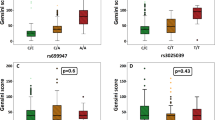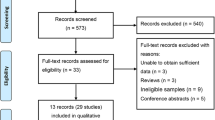Abstract
Fibroblast growth factors (FGFs) and their receptors (FGFRs) play important roles in vascular system. FGFR4 rs351855 (Gly388Arg) polymorphism has shown to be a risk factor for many diseases. The aim of this study was to investigate the association between FGFR4 polymorphisms and the susceptibility to coronary artery disease (CAD) in the Chinese population. We identified three polymorphisms in the FGFR4 gene, rs351855G/A (Gly388Arg), rs145302848C/G and rs147603016G/A, by polymerase chain reaction–restriction fragment length polymorphism (PCR–RFLP) in 658 CAD cases and 692 healthy controls. Results showed that frequencies of GA genotype, AA genotype and A allele in rs351855 (Gly388Arg) polymorphism were significantly lower in CAD patients than in controls [odds ratio (OR) = 0.79, 95 % confidence intervals (CI) 0.62–0.99, P = 0.042; OR = 0.58, 95 % CI 0.41–0.81, P = 0.002; and OR = 0.77, 95 % CI 0.66–0.90, P = 0.001, respectively]. The rs147603016GA genotype and A allele also showed lower numbers in CAD cases (OR = 0.58, 95 % CI 0.36–0.93, P = 0.025; and OR = 0.59, 95 % CI 0.40–0.95, P = 0.028). The rs145302848C/G polymorphism did not show any correlation with CAD. Haplotype analysis revealed that the prevalence of ACG haplotype (rs351855, rs145302848 and rs147603016) was significantly decreased in CAD patients (P = 0.002). Our data suggested that the FGFR4 rs351855G/A (Gly388Arg) and rs147603016G/A polymorphisms could act as protective factors against CAD in the Chinese population and indicated that a single gene polymorphism could have diverse functions in different diseases.
Similar content being viewed by others
References
Gaziano TA, Britton A, Anand S, Abrahams-Gessel S, Murphy A (2010) Growing epidemic of coronary heart disease in low- and middle-income countries. Curr Probl Cardiol 35:72–115
Jackson CL, Reidy MA (1993) Basic fibroblast growth factor: its role in the control of smooth muscle cell migration. Am J Pathol 143:1024–1031
Winkles JA, Friesel R, Burgess WH, Howk R, Mehlman T, Weinstein R, Maciag T (1987) Human vascular smooth muscle cells both express and respond to heparin-binding growth factor I (endothelial cell growth factor). Proc Natl Acad Sci USA 84:7124–7128
Tan EM, Levine E, Sorger T, Unger GA, Hacobian N, Planck B, Iozzo RV (1989) Heparin and endothelial cell growth factor modulate collagen and proteoglycan production in human smooth muscle cells. Biochem Biophys Res Commun 163:84–92
Folkman J, Klagsbrun M (1987) Angiogenic factors. Science 235:442–447
Baird A, Mormede P, Bohlen P (1985) Immunoreactive fibroblast growth factor in cells of peritoneal exudate suggests its identity with macrophage-derived growth factor. Biochem Biophys Res Commun 126:358–364
Schweigerer L, Neufeld G, Friedman J, Abraham JA, Fiddes JC, Gospodarowicz D (1987) Capillary endothelial cells express basic fibroblast growth factor, a mitogen that promotes their own growth. Nature 325:257–259
Hughes SE, Crossman D, Hall PA (1993) Expression of basic and acidic fibroblast growth factors and their receptor in normal and atherosclerotic human arteries. Cardiovasc Res 27:1214–1219
Lindner V, Lappi DA, Baird A, Majack RA, Reidy MA (1991) Role of basic fibroblast growth factor in vascular lesion formation. Circ Res 68:106–113
Bjornsson TD, Dryjski M, Tluczek J, Mennie R, Ronan J, Mellin TN, Thomas KA (1991) Acidic fibroblast growth factor promotes vascular repair. Proc Natl Acad Sci USA 88:8651–8655
Reidy MA, Lindner V (1991) Basic FGF and growth of arterial cells. Ann N Y Acad Sci 638:290–299
Wu MT, Hwang ST (2002) CXCR5-transduced bone marrow-derived dendritic cells traffic to B cell zones of lymph nodes and modify antigen-specific immune responses. J Immunol 168:5096–5102
Casscells W, Lappi DA, Olwin BB, Wai C, Siegman M, Speir EH, Sasse J, Baird A (1992) Elimination of smooth muscle cells in experimental restenosis: targeting of fibroblast growth factor receptors. Proc Natl Acad Sci USA 89:7159–7163
Cuevas P, Gonzalez AM, Carceller F, Baird A (1991) Vascular response to basic fibroblast growth factor when infused on to the normal adventitia or into the injured media of the rat carotid artery. Circ Res 69:360–369
Nabel EG, Yang ZY, Plautz G, Forough R, Zhan X, Haudenschild CC, Maciag T, Nabel GJ (1993) Recombinant fibroblast growth factor-1 promotes intimal hyperplasia and angiogenesis in arteries in vivo. Nature 362:844–846
Eisemann A, Ahn JA, Graziani G, Tronick SR, Ron D (1991) Alternative splicing generates at least five different isoforms of the human basic-FGF receptor. Oncogene 6:1195–1202
Champion-Arnaud P, Ronsin C, Gilbert E, Gesnel MC, Houssaint E, Breathnach R (1991) Multiple mRNAs code for proteins related to the BEK fibroblast growth factor receptor. Oncogene 6:979–987
Werner S, Duan DS, De Vries C, Peters KG, Johnson DE, Williams LT (1992) Differential splicing in the extracellular region of fibroblast growth factor receptor 1 generates receptor variants with different ligand-binding specificities. Mol Cell Biol 12:82–88
Templeton TJ, Hauschka SD (1992) FGF-mediated aspects of skeletal muscle growth and differentiation are controlled by a high affinity receptor, FGFRI. Dev Biol 154:169–181
Mikawa T (1995) Retroviral targeting of FGF and FGFR in cardiomyocytes and coronary vascular cells during heart development. Ann N Y Acad Sci 752:506–516
Wang J, Yu W, Cai Y, Ren C, Ittmann MM (2008) Altered fibroblast growth factor receptor 4 stability promotes prostate cancer progression. Neoplasia 10:847–856
Frullanti E, Berking C, Harbeck N, Jézéquel P, Haugen A, Mawrin C, Parise O Jr, Sasaki H, Tsuchiya N, Dragani TA (2011) Meta and pooled analyses of FGFR4 Gly388Arg polymorphism as a cancer prognostic factor. Eur J Cancer Prev 20:340–347
Wang W, Song H, Liu J, Song B, Cao X (2011) CD86 + 1057G/A polymorphism and susceptibility to osteosarcoma. DNA Cell Biol. doi:10.1089/dna.2011.1211
Liu Y, He Z, Feng D, Shi G, Gao R, Wu X, Song W, Yuan W (2011) Cytotoxic T-lymphocyte antigen-4 polymorphisms and susceptibility to osteosarcoma. DNA Cell Biol. doi:10.1089/dna.2011.1269
Ma L, Song H, Zhang M, Zhang D (2011) Lysyl oxidase G473A polymorphism is associated with increased risk of coronary artery diseases. DNA Cell Biol. doi:10.1089/dna.2011.1261
Yang Y, Zhou Y, Lu M, An Y, Li R, Chen Y, Lu DR, Jin L, Zhou WP, Qian J, Wang HY (2011) Association between fibroblast growth factor receptor 4 polymorphisms and risk of hepatocellular carcinoma. Mol Carcinog. doi:10.1002/mc.20805
Xu W, Li Y, Wang X, Chen B, Wang Y, Liu S, Xu J, Zhao W, Wu J (2010) Transmembrane domain polymorphism and cancer risk: a meta-analysis including 8555 subjects. Eur J Cancer 46:3332–3338
Eswarakumar VP, Lax I, Schlessinger J (2005) Cellular signaling by fibroblast growth factor receptors. Cytokine Growth Factor Rev 16:139–149
Matsumoto-Yoshitomi S, Habashita J, Nomura C, Kuroshima K, Kurokawa T (1997) Autocrine transformation by fibroblast growth factor 9 (FGF-9) and its possible participation in human oncogene. Int J Cancer 71:442–450
Leung HY, Gullick WJ, Lemoine NR (1994) Expression and functional activity of fibroblast growth factors and their receptors in human pancreatic cancer. Int J Cancer 59:667–675
Jaakkola S, Salmikangas P, Nylund S, Partanen J, Armstrong E, Pyrhönen S, Lehtovirta P, Nevanlinna H (1993) Amplification of fgfr4 gene in human breast and gynecological cancers. Int J Cancer 54:378–382
Lehtola L, Partanen J, Sistonen L, Korhonen J, Wärri A, Härkönen P, Clarke R, Alitalo K (1992) Analysis of tyrosine kinase mRNAs including four FGF receptor mRNAs expressed in MCF-7 breast-cancer cells. Int J Cancer 50:598–603
Takahashi A, Sasaki H, Kim SJ, Kakizoe T, Miyao N, Sugimura T, Terada M, Tsukamoto T (1999) Identification of receptor genes in renal cell carcinoma associated with angiogenesis by differential hybridization technique. Biochem Biophys Res Commun 257:855–859
Conflict of interest
No competing financial interests exist.
Author information
Authors and Affiliations
Corresponding author
Additional information
An erratum to this article is available at http://dx.doi.org/10.1007/s11033-016-3985-z.
The Editor-in-Chief of Molecular Biology Reports retracts the above-mentioned article per the Committee on Publication Ethics guidelines on plagiarism. The article duplicates (copies) significant paragraphs from the following main source/sources: Lan Ma, Haifeng Zhang, Carrie Han, Danian Tong, Meiyan Zhang, Yi'an Yao, Yu Luo, and Xuebo Liu, Fibroblast Growth Factor Receptor 4 Polymorphisms and Susceptibility to Coronary Artery Disease, DNA and Cell Biology. June 2012, 31(6): 1064-1069. doi:10.1089/dna.2011.1552.
Chen H, Tong J, Zou T, Shi H, Liu J, Du X, Yang J, Ma C, Fibroblast growth factor receptor 4 polymorphisms are associated with coronary artery disease. Genet Test Mol Biomarkers, 16:952–956, 2012.
These two articles were submitted within a relatively short time from each other which constitutes duplicate submission. In addition, further investigation showed irregularities in the peer review process leading us to believe that the peer review process was compromised.
About this article
Cite this article
Zhu, Q., Liu, T. RETRACTED ARTICLE: Fibroblast growth factor receptor 4 polymorphisms and coronary artery disease: a case control study. Mol Biol Rep 39, 8679–8685 (2012). https://doi.org/10.1007/s11033-012-1723-8
Received:
Accepted:
Published:
Issue Date:
DOI: https://doi.org/10.1007/s11033-012-1723-8




